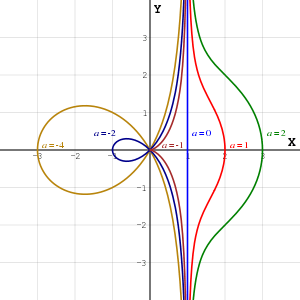Conchoid of de Sluze

The Conchoid of de Sluze for several values of a
The conchoid(s) of de Sluze is a family of plane curves studied in 1662 by René François Walter, baron de Sluze.[1]
The curves are defined by the polar equation
- .
In cartesian coordinates, the curves satisfy the implicit equation
except that for a=0 the implicit form has an acnode (0,0) not present in polar form.
They are rational, circular, cubic plane curves.
These expressions have an asymptote x=1 (for a≠0). The point most distant from the asymptote is (1+a,0). (0,0) is a crunode for a<−1.
The area between the curve and the asymptote is, for ,
while for , the area is
If , the curve will have a loop. The area of the loop is
Four of the family have names of their own:
- a=0, line (asymptote to the rest of the family)
- a=−1, cissoid of Diocles
- a=−2, right strophoid
- a=−4, trisectrix of Maclaurin
References
- ↑ Smith, David Eugene (1958), History of Mathematics, Volume 2, Courier Dover Publications, p. 327, ISBN 9780486204307.
This article is issued from Wikipedia - version of the 11/2/2016. The text is available under the Creative Commons Attribution/Share Alike but additional terms may apply for the media files.